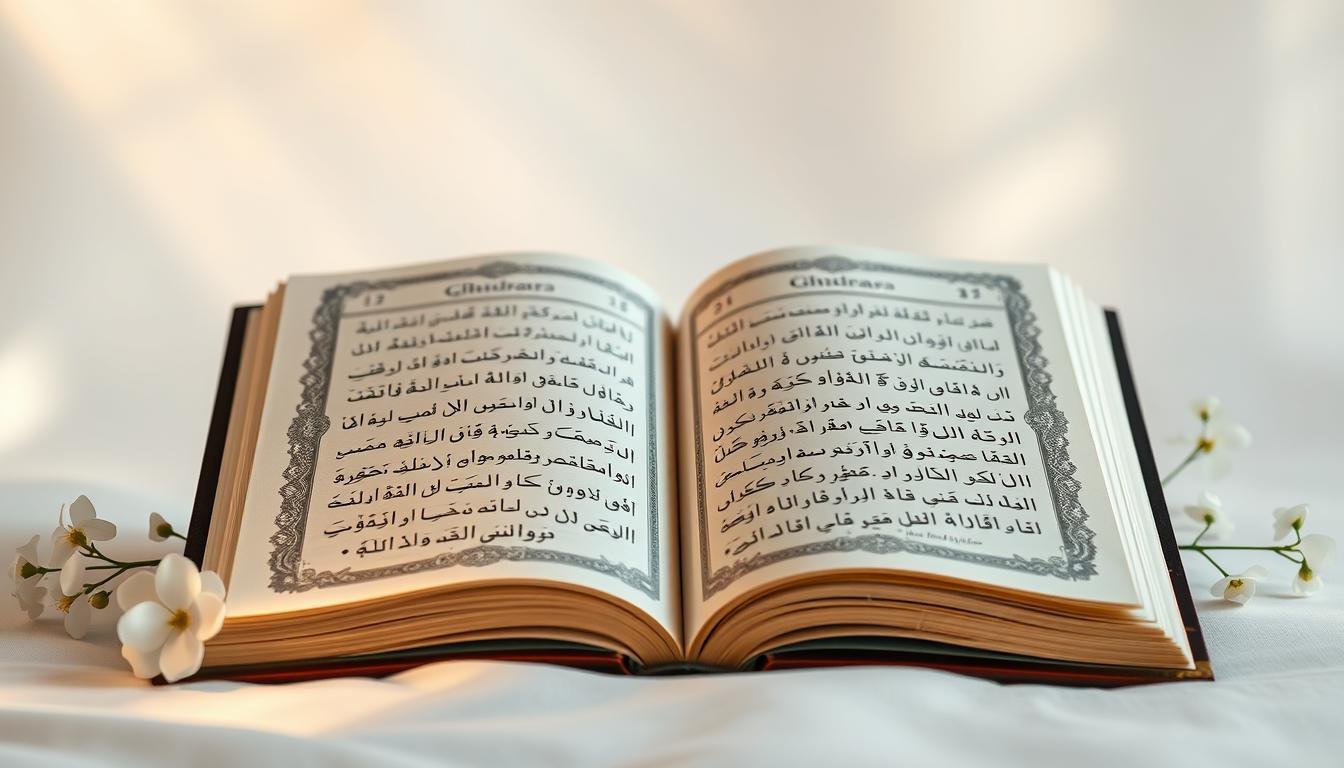Have you ever thought about why the Quran talks about hijab as a matter of modesty, not just clothes? What Does The Quran Say About Hijab? This makes us think differently about what Islamic modesty means. The Quran talks about hijab in Surah An-Nur and Surah Al-Ahzab. It gives rules for both women and men about how they should act and dress.
This invites us to look deeper into what hijab means in Islamic teachings.
Understanding the Concept of Hijab in Islam
The hijab in Islam is more than just a piece of cloth. It’s a symbol of faith and culture. Over time, hijab has changed from a simple custom to a key part of faith. This change shows how society’s views on modesty have shaped our understanding of hijab.
Historical Significance of Hijab
In early Islamic times, wearing hijab was seen as crucial for modesty in women. Today, people see hijab differently, but back then, it meant covering the head and body. Women who dressed modestly were often more respected than those who didn’t.
Interestingly, women in the West also wore head coverings until the 19th century. This shows how hijab is a global practice with similar meanings across cultures.
Different Interpretations Across Cultures
How people see hijab varies a lot around the world. In some places, it’s a sign of faith and following Islamic rules. In others, it’s a traditional outfit with local touches.
For example, nuns in the West wear clothes that show their commitment to modesty, similar to hijab. In work settings, people wear different hijab styles, showing how it can be flexible. This shows how hijab fits into different cultures and faiths, making it special in each community.
What Does The Quran Say About Hijab
The Quran teaches us about modesty through its guidance on dress code. It’s important to understand the context and details of these verses. Surah An-Nur and Surah Al-Ahzab are key texts that explain modesty and what both men and women should do.
Specific Verses Addressing Hijab
In Surah An-Nur (24:30-31), the Quran tells Muslim men and women to be modest in their actions and clothes. It says women should cover their bosoms. This teaches us about being decent and respectful towards others.
Surah Al-Ahzab (33:59) also talks about women wearing outer garments when they go out. This is to protect them from harassment. These verses show us how to dress modestly for our own dignity and safety.
Context of the Verses
These verses came at a time when social issues and harassment were common. They encourage believing women to identify themselves in a safe way. The Quran doesn’t say there are penalties for not wearing the hijab. It’s about personal choice and being modest, not forced rules.
Over time, hijab has taken on different meanings in different places. Sometimes, it’s seen as more than just following the Quran’s teachings.
You may also be interested in:
Key Verses Related to Hijab in the Quran
The Quran gives us key lessons on hijab, mainly in Surah An-Nur and Surah Al-Ahzab. These chapters talk about how believers should dress and act. They stress the need for modesty and protection.
Surah An-Nur (Chapter 24) Insights
Surah An-Nur sheds light on women’s modesty. Verse 24:31 tells women to cover their heads and bosoms. This rule is about more than just clothes. It also talks about acting modestly.
Surah Al-Ahzab (Chapter 33) Interpretations
Surah Al-Ahzab builds on Surah An-Nur’s teachings. Verse 33:59 says women should wear their outer clothes tightly when outside. This helps protect their faith and keeps them safe from harm. These verses focus on how women look and act, showing the Quran’s view on hijab.

The Essence of Modesty in Islam
Islamic modesty is more than just wearing certain clothes. It’s about how we act and interact with others. The Quran teaches that being modest is a key part of faith. It helps us respect ourselves and others, showing we are committed to values like humility and dignity.
The Role of Attitude and Behavior
Islamic teachings stress the importance of how we behave. They talk about ḥayāʾ, or feeling ashamed in a good way. This feeling helps us stay decent and morally right. Imam Ja’far as-Sadiq said modesty shows our faith through our actions.
The Quran tells both men and women to watch their actions and how they act in different situations.
Modesty Beyond Clothing
Wearing modest clothes is part of being modest, but it’s not the whole story. Our character and how we interact with others are key. Surah An-Nur and Surah Al-Ahzab give us guidelines for staying pure and dignified.
Women are told to show their beauty wisely, showing modesty goes beyond what we wear. This approach helps us be respectful, kind, and ethical. It shapes how we live our lives.
Common Misconceptions About Hijab
The hijab is often misunderstood, seen as more than just a cloth by many women. It’s key to grasp the reasons behind these wrong ideas, especially the debate over whether hijab is a sign of oppression or hijab empowerment. Feminists see wearing hijab as a bold statement of freedom, linked to female liberation. This choice goes against the norm, letting women show who they are through their beliefs and values.
Hijab as Oppression vs. Empowerment
In the last twenty years, many women have chosen to wear the hijab, facing different views on its meaning. It’s not just a fashion statement, but a way of life for many. Verses in the Quran, like 24:31 and 33:59, show how the hijab brings modesty and spiritual joy.
Women in hijabs succeed in fields like science, medicine, and the arts, proving their choice doesn’t limit them. It’s wrong to think they ignore their looks; many keep their hair neat under their hijabs. With new materials, wearing hijab is now practical for various climates, showing it’s a choice that works well in everyday life.
While some may be forced to wear hijab in certain places, this doesn’t define the true Islamic way, which values free will. Quran 2:256 says “There is no compulsion in religion.” This shows that true freedom means making choices about one’s body and clothes.
Head coverings have been part of many cultures, showing the hijab is not a single idea of dress. Men also follow modesty rules, covering from navel to knees. Different hijab styles reflect personal taste and heritage, proving there’s variety in how people choose to cover.
Wearing the hijab is a way to seek divine love and protection, helping women deal with society’s expectations while being true to themselves. It’s a sign of female liberation, showing strength and self-expression across cultures and time.
Differences Between Hijab Terms in the Quran
The Quran uses specific terms for modest clothing, like “khimar” and “jilbab.” These terms help us understand the hijab better and its role in culture. They show how Islam teaches modesty and respect.
Meaning of Khimar and Jilbab
The word khimar in the Quran means a special head covering. It’s talked about in Surah An-Nur (24:31). This covering is meant to hide the chest and neck, showing the value of modesty. Women are told not to show off their beauty or cleavage, keeping dignity and respect in mind.
The jilbab, on the other hand, is a loose outer garment for women. The Quran says in verse 33:59 that women should wear their outer clothes low for safety and recognition. This rule doesn’t give exact measurements, letting cultures decide while keeping modesty in mind.
Gender Perspectives in Quranic Verses
The Quran teaches us about modesty for both men and women. It tells men to be modest in how they look at others. This shows us how important it is to respect each other. By following these teachings, we can build a society based on respect and moral values.
Modesty Guidelines for Men and Women
Some verses in the Quran talk about what women should do to be modest. For example, Surah An-Nūr (Quran 24:31) says women should cover their necklines and charms, but only in front of close family. This was important back then because women often wore their necks bare.
Another important verse is in Surah Al-Ahzab (Quran 33:59). It tells women to wear jilbāb to protect themselves from being bothered in public. This was because women faced safety issues when they went out at night. These teachings help women stay dignified in how they act in public.
These guidelines show the Quran’s aim to set clear moral standards for everyone. In Islam, God’s words guide us on how to behave. They help us respect each other and build a better society.
Implications of Quranic Teachings on Modern Hijab Practices
The Quran’s teachings deeply influence modern hijab practices worldwide. These teachings shape how people wear the hijab in different cultures. They highlight the importance of modesty, as seen in Surah An-Nur (24:31). This has led to many global hijab variations that fit with local laws and customs.
Global Variations in Hijab Implementation
In some places, wearing hijab is required by law, while in others, it’s a personal choice. The debate over Karnataka’s hijab ban in schools shows how laws affect women’s rights. Many women choose to wear hijab based on their beliefs about modesty and their culture. This shows the complex discussions around the cultural influence hijab has in different places.
Impact of Cultural Practices on Hijab
Looking into hijab shows how culture shapes it. Orthodox Jewish and Christian communities also have head coverings as part of their faith. In some cultures, wearing a veil was seen as a sign of respect and high social status.
Like orthodox Jewish women, modern hijabi women see their practice as a way to show faith and cultural identity. The Prophet’s teachings stress the need to balance faith with obeying the law and valuing education. This balance lets women make choices that respect their faith and culture in a diverse society.
Broader Spirituality Beyond Hijab in Islam
Hijab is important in Islamic faith, but it’s part of a bigger spiritual picture. Spirituality in Islam goes way beyond just wearing modest clothes. It’s about living with ethics, being true to oneself, and truly believing in faith. We should see hijab as just one part of living a spiritual life.
The Quran tells both men and women to be modest and respectful. It’s not just about what you wear. It’s about being kind, fair, and compassionate, as taught in Islam. The way people see hijab shows that being spiritual in Islam can look different for everyone.
Being spiritual in Islam means doing many things that have nothing to do with hijab. Scholars and followers of Islam keep looking into what it means to live a good life. They show that being true to your faith is about how you act and think, not just how you dress.
FAQ
What Does The Quran Say About Hijab?
How do various cultures interpret the hijab?
What specific verses in the Quran address the hijab?
Why are the verses about hijab contextually significant?
What insights can be gained from Surah An-Nur regarding hijab?
How does Surah Al-Ahzab contribute to our understanding of hijab?
What does modesty encompass in Islam beyond clothing?
What are some common misconceptions about hijab?
How do the terms ‘khimar’ and ‘jilbab’ differ in the Quran?
How does the Quran approach modesty for both genders?
What influences modern hijab practices around the world?
How does hijab fit into the broader context of spirituality in Islam?

Embracing Faith, One Insight at a Time!
The teachings of the Quran have always guided my path. With a deep passion for Islamic knowledge, I strive to blend the wisdom of tradition with the relevance of today, making the timeless messages of Islam accessible and meaningful for everyone.
Muslim Culture Hub is my platform to share historical insights and thought-provoking articles, exploring both well-known and lesser-discussed aspects of Islamic culture and beliefs. My mission is to create an inclusive online space where everyone can learn, strengthen their faith, and connect with the profound message of Islam.
Join the journey!
May peace be upon you.







